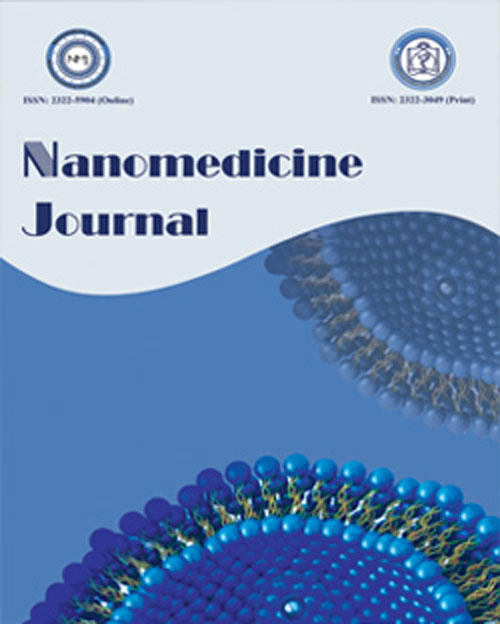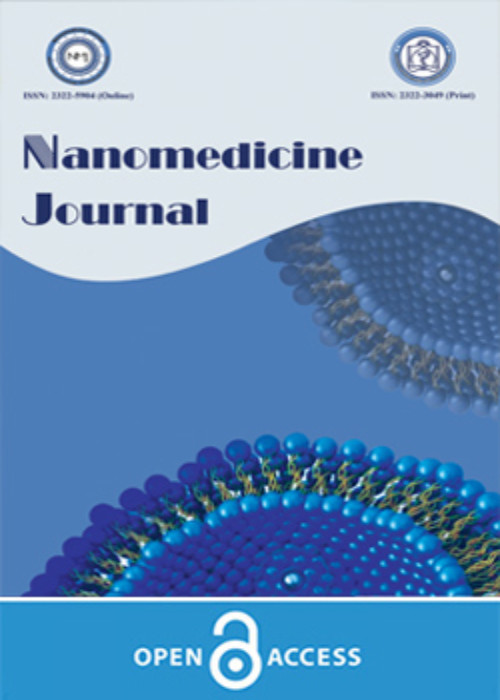فهرست مطالب

Nanomedicine Journal
Volume:9 Issue: 3, Summer 2022
- تاریخ انتشار: 1401/04/04
- تعداد عناوین: 8
-
-
Pages 180-191
The domain of Janus nanoparticles (JNPs) has seen a surge in research and development during the last decade. JNPs are anisotropic composite innovations with remarkable characteristics that depict a peculiar class of particles, which integrate the features and functions of multiple materials into a single unit. Janus particles are superior prospects for several high-end applications due to their possible modifications by “click chemistry”. JNPs offer new possibilities by combining the features of components. Janus nanoparticles can pack multiple pharmaceuticals and imaging contrast agents simultaneously since they have a distinct chemical configuration on different sides. As a result, they become ideal for administration and bioimaging at once. They have sparked interest due to their exceptional architecture and their potential implications in science and engineering, biological application, and most notably, theranostics. The emphasis of this review is on the latest advancement in the fabrication and implementation of innovative Janus nanoparticles, along with their spectacular performance in therapeutic delivery applications.
Keywords: Biomedical applications, Janus, Multifunctional, Nanoparticles -
Pages 192-204
Extracellular vesicles (EVs) are small molecules produced by most cells that may aid in cell communication. They can transfer functional biomolecules from one cell to the next, and even across the body. Exosomes are some of the most studied extracellular vesicle components. Many medications may be incorporated into exosomes and then disseminated to specific organs, tissues, and cells to provide tailored medication administration. According to a new study, exosomes, which are produced by cells, have a variety of functions and aims. Several studies have proven that a broad variety of cargo may be effectively transported to the precisely specified cells. For this reason, EVs are often used to carry medicinal substances as treatment. The researchers used exosomes that had been treated with additional chemicals to boost their transportability. Exosomes offer a number of advantages over other drug delivery technologies such as nanoparticle-based systems, liposomes, and even polymeric nanoparticles. Due to their similar nature to the body’s own cells, exosomes have no immunogenicity. Because of their nanoscale size, exosomes are the most promising strategy for medicine delivery to specific tissues and organs, and they have gotten the greatest attention in recent years. The ability of natural and manufactured exosomes to convey a variety of cargo to the target cell is investigated in this article.
Keywords: Cancer, Drug delivery systems, Exosome, Nanoparticles -
Pages 205-215Objective(s)The purpose of this study is to synthesizing and characterizing niosomes containing curcumin in order to delivery to bone cancer cells. Nano-carriers were synthesized using thin film method and curcumin was loaded into them by active hydration method.Materials and MethodsThe optimal formula was selected based on the encapsulation efficiency and release profile. Then the physicochemical properties of nanoparticles such as size and zeta potential, morphology and system-drug interaction were evaluated by using DLS, SEM, AFM and FTIR methods. Finally, the toxicity of nanosystems on bone cancer cell line MG-63 as resistant cells to treatment was examined by MTT assay.ResultsNiosomes containing curcumin with size of 90.8 nm, PDI of 0.236, zeta potential of -8.9 and encapsulation rate of 73.5 ± 1.8 have slow-release profile. The maximum release rate of the drug for this nano-carrier in healthy and cancerous within 72 hr was 60.12% and 64.35% respectively. IR and morphological investigations showed no chemical interaction between curcumin and nanocarrier and the particles are spherical in shape. The results of the MTT assay also showed that by encapsulating curcumin, its effect on bone cancer cells increased and the resistance of MG-63 cells to treatment decreased.ConclusionThe results of this study showed that niosomes containing curcumin with appropriate physicochemical properties can improve the treatment process in bone cancer cells and also reduce the resistance of this cell to the drug and could be proposed as a new therapeutic strategy to help the treatment of osteosarcoma.Keywords: Bioactive compound, Curcumin, MG-63 cells, Niosomal nanoparticles, Osteosarcoma
-
Pages 216-222Objective(s)
The present work aimed to assess the protective impacts of nanosilymarin or silymarin on colitis induced by TNBS in rats.
Materials and MethodsInduction of acute colitis was conducted by rectally administering 2 ml of TNBS solution. About 2 hr followed by induction of colitis, the rates were given dexamethasone (2 mg / kg), normal saline, silymarin (50, 100, and 200 mg / kg), and nanosilymarin (50,100, and 200 mg / kg) orally for two weeks. Damage was assessed at the macroscopic and microscopic levels. MPO enzyme activity was measured using biochemical technique and also ELISA kit was used to measure tissue levels of TNF-α and IL-1β and Western blot analysis was utilized to study the expression level of P65 TLR4 and pNF-κB proteins.
ResultsAccording to the results, dexamethasone (2 mg / kg) and nanosilimarin (200 mg / kg) reduced tissue damages than the TNBS group (P<0.001). Moreover, these drugs reduced MPO activity (P<0.001) and levels of TNF-α and IL-1β (P<0.001) in colon tissue than the TNBS group and also the expression of p65 TLR4 and pNF-κB proteins was decreased when in comparison to the TNBS group.
ConclusionIt is proposed that nanosilimarin reduce colon inflammation in TNBS-induced experimental colitis by inhibition of the TLR4 / NFκB molecular pathway.
Keywords: Colitis, Nanosilymarin, TLR4, NF-κB, TNBS -
Pages 223-230Objective(s)Invasomes are nano-sized vesicular systems made of ethanol, soybean phosphatidylcholine and terpenes that promote skin penetration by disrupting the lipoidal structure of stratum corneum, interacting with the matrix proteins and augmenting the partitioning of the drug moiety in the skin layer. Curcumin is a well-known bright yellow coloured polyphenol which is produced by the plants of curcuma long class belonging to family Zingiberaceae. It is being used in the therapeutic field since ancient times for the treatment of several diseases. It is a complex molecule with substantial activity against a number of ailments. Despite having a number of health benefits, curcumin’s limited water solubility and poor skin penetration are the major barriers in its transdermal application.Materials and MethodsIn present research work, terpenoid invasomal nano vesicles of curcumin were prepared using mechanical dispersion process with eucalyptol as the permeation enhancer. The prepared invasomal formulations were characterised and optimised in terms of entrapment efficiency, vesicle size, in vitro drug release, ex vivo permeation and skin retention analysis.ResultsThe transmission electron microscope confirmed the presence of spherical-shaped vesicles with a vesicle size of 461.57± 1.38 nm and 80.54 ± 0.38 % entrapment efficiency. In vitro release kinetics conformed well with Higuchi kinetic model for release. Ex vivo study confirmed that the curcumin permeation across the pig ear skin from the optimised formulation was 2.5 times higher than curcumin solution and had a flux of 179.44±0.26 µg/cm2/h.ConclusionThe study suggests that invasomes have a high potential for transdermal administration of curcumin which can increase the topical utility of curcumin in several skin diseases.Keywords: Invasomes, Permeation enhancer, Skin, Terpene
-
Pages 231-240Objective(s)Today, cancer is one of the health concerns in modern societies. The use of nanoparticles in medical science has created new possibilities for diagnosis, imaging of tumors, and treatment of cancer in humans.Materials and MethodsIn this study, chitosan nanoparticles modified with quinic acid were used to diagnose breast cancer using a single-photon emission computed tomography imaging technique. For this purpose, quinic acid was activated by EDC/NHS and then binding was performed by adding chitosan nanoparticles.ResultsTEM, DLS, FTIR, and LC/MASS analyzes were used to investigate this conjugation. MTT toxicity test showed no toxicity on the HEK-293 cell lines and therapeutic properties for the MCF-7 cell line. The response surface method depends on the central composite design that was applied. For the highest labeling efficiency, using 3 factors: the amount of chitosan-quinic acid, pH, and SnCl2 as a reducing agent, and the efficiency of labeling was evaluated by thin-layer chromatography (TLC).ConclusionFinally, the study of biodistribution using SPECT imaging in cancer mice and its comparison with blocking tests showed that this compound has a good ability to diagnose breast cancer.Keywords: Blocking, Breast Cancer, Chitosan, Quinic acid, SPECT imaging
-
Pages 241-251Objective(s)The purpose of this work was to estimate the anti-cancer properties of the nanoemulsions synthesized by Zingiber officinale L. tincture against PC3 prostate cancer cells.Materials and MethodsFresh ginger was initially procured from a local market, and extraction was performed after complete washing. In the next step, a nanoemulsion containing ginger extract was prepared using Tween 80, and its size and zeta potential were determined by a Zetasizer. The prepared nanoemulsion was assessed by transmission electron microscopy (TEM) to confirm the size and morphology of the particles. The toxicity of the nanoemulsion containing ginger extract against PC3 prostate cancer cells and normal HFF skin cells was evaluated using the MTT assay. To determine apoptosis, flow cytometry was used to assess cell cycle changes. In addition, the antioxidant activity of the nanoemulsion was estimated by DPPH and ABTS free radical scavenging tests.ResultsThe results showed that the prepared nanoparticles had a size of 67 nm (confirmed by TEM electron microscopy) and a zeta potential of -25.05 mV. The results of the MTT assay showed inverse dose-dependent toxicity for different concentrations of ginger nanoemulsion against PC3 cells. In addition to anti-cancer activity, the nanoemulsion showed a potent ability to scavenge DPPH and ABTS free radicals.ConclusionOur results showed that the nanoemulsions containing ginger extract had toxicity against PC3 cancer cells but not normal cells, indicating their applicability as a suitable option for treating PC.Keywords: Cell cycle, Free radical, Nanoparticle, Prostate cancer, Zingiber officinale
-
Pages 252-260Objective(s)
Encapsulation of essential oils (EOs) into the nano-carrier leads to reduced EOs volatility and oxidation, as well as increased therapeutic efficiency. This study assessed the chemical composition and cytotoxic effects of cumin essential oil (CEO) and nano-encapsulation cumin essential oil (NECEO) against three cancer cell lines.
Materials and MethodsSolid lipid nanoparticle (SLN) formulations were evaluated for their size, zeta potential and encapsulation efficiency (EE). Isolation of the CEO and NECEO and their chemical composition were analyzed by gas chromatography-mass spectrometry (GC/MS). Cytotoxicity of CEO and NECEO against human lung cancer (A549), human breast cancer (MCF7), and human prostate cancer (PC3) was examined using MTT assay.
ResultsOur findings showed that in CEO and NECEO, the major component was cuminaldehyde (24.5 and 26.0%, respectively). GC/MS analysis of NECEO chemical composition exposed 27 components in EOs accounting for 91.5 and 98.9% of CEO and NECEO, respectively. The results showed that solid lipid nanoparticle (SLN) induced the concentration of the main volatile components. Based on the characterization of SLN, the EE percent ranged from 23.00±4.1% to 96.21±5.5%. The loading capacity (LC) of NECEO ranged between 0.00±0.0 to 7.05±0.5%. Moreover, the yield of NECEO was 79.14%. Based on results, Z-average, polydispersity index, and zeta potentials of formulation were 1252±21.4 nm, 0.423±0.03, and 17±0.52, respectively. The IC50 value of NECEO (after 48 h) against MCF7, A549, and PC3 (108, 213, and 124 μg/mL, respectively) was significantly lower than CEO (231, 219, and 325 μg/mL, respectively).
ConclusionThe results suggested that NECEO can be regarded as a promising nutrient source. These observations could be used as a basis for future experiments to further evaluate potential nanoparticles and other medicinal plant species.
Keywords: Breast Cancer, Cuminum cyminum, Lung cancer, Prostate cancer, Solid lipid nanoparticle


